Patriotic commemorations
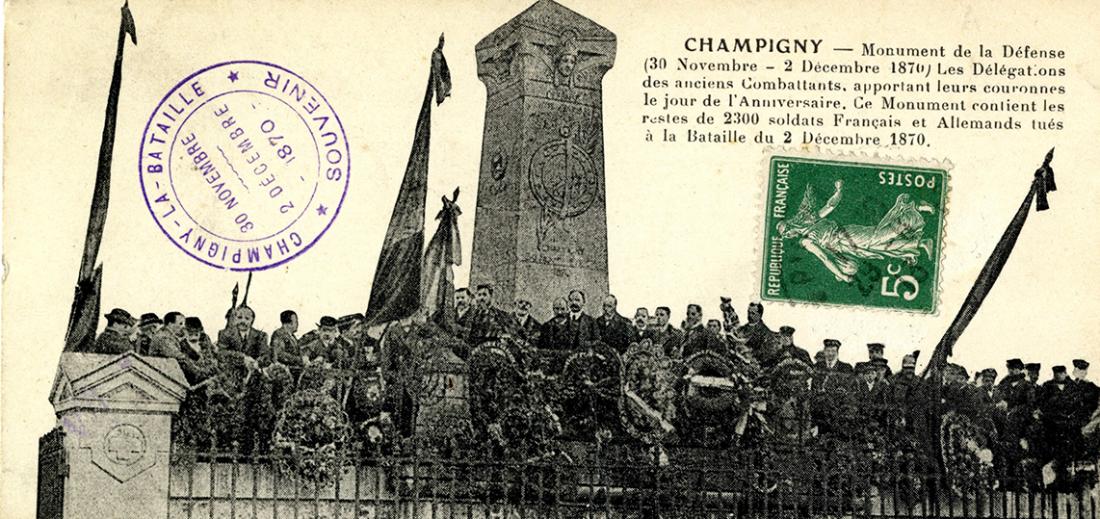
With the end of the First World War came the need for the French nation to honour the men who had died and strengthen national cohesion around a shared memory. Today, the deaths of the last remaining survivors give commemorations a new raison d’être: to give meaning to the sites and pass on the memory of our forebears.
Patriotic commemorations are a means of paying tribute to servicemen and women who “died for France”. Established in the wake of the “victorious defeat” of the Franco-Prussian War (1870-71) and reinforced following the First World War, they were conceptualised by Ernest Renan in his famous speech of 1882 at the Sorbonne, on the theme of “the Nation”.
“A nation is a soul, a spiritual principle. Two things which are, in fact, but one, make up that soul, that spiritual principle. One is in the past, the other in the present. One is the shared possession of a rich legacy of memories; the other is the current consent, the desire to live together in harmony, the will to go on asserting the heritage we have received undivided.”
For Ernest Renan, the past to be safeguarded was first and foremost that of the great men who had brought glory to the Nation. “A heroic past, of great men and glory: that is the capital on which the idea of a nation is founded.”
But that past was also, and above all, one of collective mourning. “Shared suffering unites more than joy! In terms of national memories, mourning is worth more than triumph, for it imposes duties and requires a joint effort.”
Patriotic commemoration in its entirety is in Ernest Renan’s text. Thirty-four years before 11 November was established as a national holiday in France, the great historian and philosopher had conceptualised the ceremony, as a source of national cohesion.
These commemorations comprise three key elements.
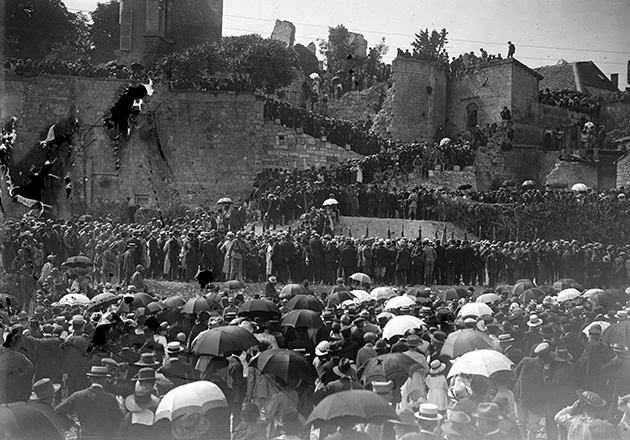
The first commemoration of the liberation of the town of Verdun, 23 June 1920. © Excelsior-L’Équipe/Roger-Viollet
Locating patriotic commemorations
First of all, there is the territorial aspect. For there to be a commemoration, a commemorative site is required. Commemorations are not held in fields or on streets, even if a field or a street is where the historical events took place. Commemorations are held before a grave, a monument, a stele or a plaque.
Two sites were created as venues for patriotic commemorations.
Firstly, cemeteries – sites where the soldiers who “died for France” were buried – more specifically, the ossuaries of the Franco-Prussian War and the national cemeteries built between the wars. These sites would soon show their limitations. One had to travel to reach them – hence the creation in 1920 of the “right to pilgrimage” for the widows and children of servicemen killed in the Great War. But that right proved insufficient, and it was deemed necessary to bring the remembrance sites closer to where people lived. That necessity gave birth to the Monument aux Morts, or war memorial – the ultimate relocated site, centred on where the soldiers were born rather than where they died. The erection of 35 000 war memorials in communes across France was the cornerstone of the development of patriotic commemorations. A development that would need channelling through a structured commemorative calendar.
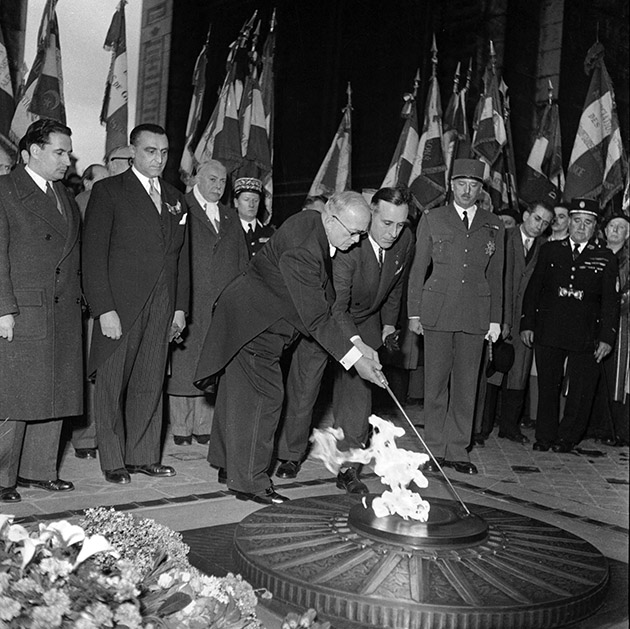
French president Vincent Auriol (1884-1966) relights the flame of the Unknown Soldier during a ceremony at the Arc de Triomphe, 8 May 1951. © LAPI/Roger-Viollet
Choices of dates
Next comes the commemorative calendar. Two types of commemorative dates were incorporated into the republican patriotic calendar. Dates in reference to an in situ battle or tragedy, such as the liberation of communes, battles of the maquis, roundups and executions, or battles of the First World War. These always historical dates were born of the meeting of two actors: veterans’ associations, comprised of those who could say “I was there, I witnessed it and those who died were my comrades”, and the municipalities that took it upon themselves to establish and manage the ceremonies. This was the case for all the major ceremonies in the beginning, from Verdun to the D-Day landing beaches.
In counterpoint to this calendar “born of the regions”, the republican State introduced general dates aimed at unifying remembrance. Like Bastille Day (14 July), incorporated in the national calendar in 1881, the French parliament established three national days in the wake of the First World War: Joan of Arc Day, the Day of Remembrance of those who died for France (1 November) and Armistice Day (11 November). Following the Second World War, two new dates were created: Deportation Day and VE Day (8 May). Each of these five national holidays is rooted in history, even if the date chosen for Deportation Day (the last Sunday of April) honours the liberation of the camp of Mauthausen over the liberation of other camps, such as Auschwitz.
The Constitution of the Fifth Republic broke with this custom. Since 1959, the French president has had the authority to determine the inclusion of new dates in the commemorative calendar. For General de Gaulle, the aim of that decision was to curb their creation by a parliament deemed too weak to stand up to pressure groups. The opposite occurred. Successive presidents have created ten national commemorative days since 1959. Some of them, which see ceremonies held in communes across France, are removed from the historical dates, and this has given rise to “intense remembrance battles”.
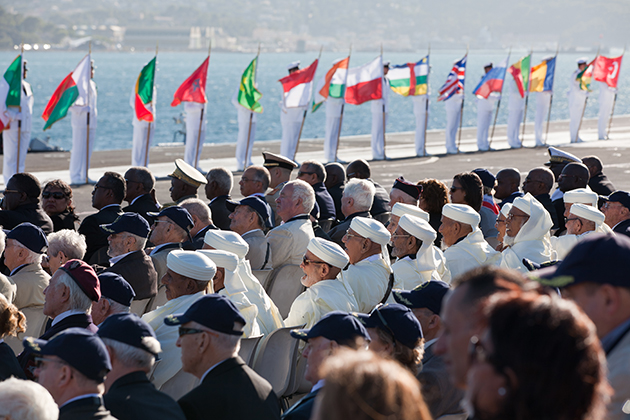
Ceremony of the 70th anniversary of the Provence landings, with Army of Africa veterans, on board the aircraft carrier Charles de Gaulle, 15 August 2014. © R. Senoussi/DICoD
Veterans, protagonists of commemoration
Last is the liturgical element. In the wake of the “victorious defeat” of the Franco-Prussian War, against a backdrop of conflict between governments and Catholic leaders, the liturgy of the patriotic ceremonies was drawn up. It was modelled on the Catholic liturgy. The minute’s silence, the contemplation, the words of the officiator, the solemn anthems (the Marseillaise), the lowering of the flags, the monument playing the role of altar, are so many references to religious ceremonies.
Besides these three elements, patriotic commemorations owe their exemplary character to their hosts. Going right back to the Franco-Prussian War, the ceremonies were created by and for the veterans. Formed into associations, veterans have always been the protagonists of commemoration. It is they who act as spokesmen, due to their proximity to their comrades killed in action. It is they who assemble for the key decennial anniversaries, and in particular for the 20th anniversaries of the First World War – at Verdun in 1936 and throughout France on 11 November 1938 – and subsequently for the anniversaries of the two world wars, especially those of 1954 (40th and 10th anniversaries), 1964 (50th and 20th anniversaries) and 1984 (70th and 40th).
The importance of these commemorative actors is such that their initial internal transformation and subsequent demographic decline have conditioned the future of the commemorations.
Let us begin with transformation. The 40th anniversaries came at a time when those who could say “I was there” had all reached retirement age and therefore formed the majority at the ceremony. This was the case of the ceremonies of Verdun in 1956 and D-Day in 1984. From the 40th anniversary onwards, subsequent generations of veterans took over as their successors. Second World War veterans (the “second generation of combatants”) predominated at the Armistice Day commemorations of 1968, while veterans of the Algerian War were in the majority at the D-Day commemorations in Normandy in 1994. The 70th and 75th anniversaries were the last commemorations to see the participation of those “who were there”.
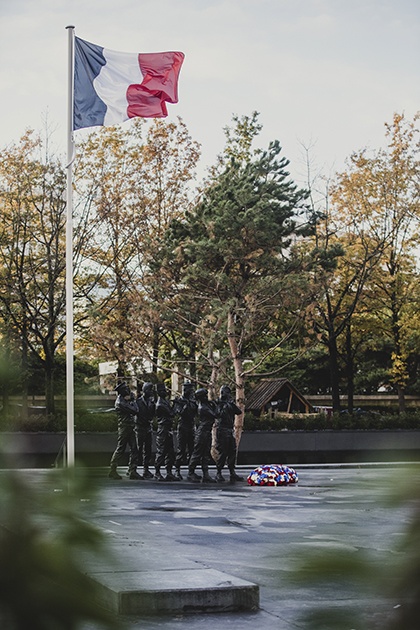
Memorial to French soldiers killed in overseas operations, inaugurated on 11 November 2019 at Parc André Citroën, Paris.
© Philippe Servent/Présidence de la République
What is the future of patriotic commemorations?
The overlapping succession of three generations of combatants – that of the First World War, the Second World War and the wars of decolonisation (Indochina and Algeria) – made it possible to prolong for almost a century the role of the veterans’ associations as hosts of the commemorations. The fourth generation of combatants – those deployed on overseas operations – comprises nearly 200 000 veterans. Yet it is highly heterogeneous in terms of the dates and places of deployment, and signals a break with the period of conscription: the service personnel deployed on overseas operations are all professional soldiers. Together with age uniformity – most of these servicemen and women are from the active population – this generation raises the question of what is the future of the French commemorative model.
While the First World War centenary mobilised the third generation of veterans, who emerged as the “natural successors to the poilus of the Great War”, the question will arise for the key Second World War anniversaries beginning with the 80th anniversary (in 2024 and 2025, in particular). Who will be the commemorative actors of tomorrow?
The shift from human remembrance – centred on the figure of the veteran – to “stone remembrance” – centred on the site where the event being commemorated took place – leaves open the question of the remembrance hosts.
Indeed, in a democracy, the State is unable to mobilise citizens if they are not structured around a central core of voluntary organisations. What is at stake, therefore, is the development of a new voluntary sector, with remembrance associations taking over as successors to the veterans’ associations.
A coordinated effort will be imperative for this new remembrance sector, comprised of five categories – the heirs to the veterans’ associations, who carry on their remembrance struggle; the “guardians” of remembrance sites, who maintain and promote the places that contain the memory of wartime events; the re-enactors of historical events, who act out the pages of history using period costumes and equipment; the genealogists who enable millions of French people to put together their family history and trace their combatant forebears; and, lastly, the educational organisations that deepen and disseminate knowledge about our wartime history. The future of patriotic commemorations will depend on it.
Serge Barcellini, Chairman, Le Souvenir Français
Commemorative sites
- Verdun Memorial
- Douaumont National Cemetery and Ossuary
- Hôtel des Invalides - The Army Museum
- National Resistance Museum
- Mémoire du Maquis, history resource
- Mémorial des Martyrs de la Déportation
- The Shoah Memorial
- National Memorial to the Algerian War and the Battles in Morocco and Tunisia
- Indochina War Memorials
- Memorial to French soldiers killed in overseas operations

